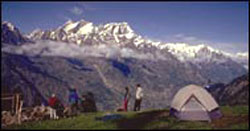| Whitewater Rafting Introduction |
|||||||||
While initially all equipment was imported, it is now also available at select outlets in India. Each raft has a river guide with 4-8 people in it, depending on whether it is a day-trip or spread over several days. River guides are expected to have several years of on-river experience. Waterproof drums or bags are kept aboard the raft for carrying cameras and for keeping baggage dry on longer multi-day expeditions. Every raft also carries rescue bags and flip lines for emergencies. A repair kit and a first-aid kit are carried on board to ensure that the run is self-contained. For safety reasons, it is always advisable to ply a minimum of two rafts on the river. |
Rafting • Himalayan Gorges • Thrills of Rafting
Adventure activities | ||||||||
It is compulsory for each person to wear a life jacket and a helmet with chin-straps. A safety briefing is given to everyone before the river run commences, which outlines everything from the nature of the river to paddling commands and safety procedures. An easy section for orientation is chosen for beginners.
 If you wish to go rafting, plan ahead. November to February is the best time for beginners. While rafting, make sure that the raft is in excellent condition. Check your life jacket and helmet. You must have either another raft or a kayak traveling with you. Choose your agency with care, because not all of them give adequate consideration to safety norms.
If you wish to go rafting, plan ahead. November to February is the best time for beginners. While rafting, make sure that the raft is in excellent condition. Check your life jacket and helmet. You must have either another raft or a kayak traveling with you. Choose your agency with care, because not all of them give adequate consideration to safety norms.
Persons suffering from hypertension, heart conditions, epilepsy, expecting mothers, or those with any serious ailment should not go rafting. Children under 15 should avoid going. It is advisable to know the basics of swimming. In no circumstances should you go rafting after consuming alcohol or any drug. Check List Of Personal Items : Rapids are graded from Class I to Class VI depending on the degree of difficulty they present in being successfully maneuvered. Grade I - Small waves, easy to negotiate. For the gentle adventurer. Grade II - Moderately difficult, but with clear passages. Sets your pulses racing. Grade III - Difficult, high irregular waves, narrow passsages, requires precise maneuvering. You are no longer in it for the cheap thrills. Action is required. Grade IV - Very difficult, powerful waves, requires skillful maneuvering. Separates the men from the boys. Grade V - Extremely difficult, long, violent and highly congested. Only for experts. This one is for Real! Grade VI - Suicidal. Unrunnable. If you have definitely lost all reason to live, and are looking for an option to Russian roulette. Photo Credit: Vaibhav Kala
|
|||||||||
Editor: Romola Butalia (c) India Travelogue. All rights reserved. |
|||||||||
